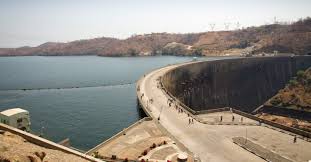Vic Falls sees low flows due to climate change: study
World famous waterfall and Zimbabwe’s number one tourist attraction, the Victoria Falls, is starting to have far lower flows because of frequent droughts triggered by climate change, new research has shown.
Most of the changes have occurred in the months October and November, where rain has become scarcer, temperatures soared and waterflow diminished.
This could have far reaching impact on the tourism sector in Zimbabwe, and the economy as a whole.
According to the research, the Victoria Falls has been hit by drought in 19 of the 40 years since 1976.
Although precipitation is up 80mm over the four decades overall, it has declined sharply in the last 20 years.
During this period, droughts have sometimes extended for up to 4 years non-stop, it says.
October, which marks the beginning of the rainy season in Zimbabwe, has particularly been the driest.
Preciptation during the month has completely dried up.
In 1976, about 40mm of rain fell in October in Victoria Falls.
Today, none does at all.
“Rain now starts in November, and has not extended beyond April, the traditional rain-end month,” said Dr Godwell Nhamo, a Zimbabwean researcher with the University of South Africa, who co-authored the report.
“That means the rainy season has shortened by a month. The delay in the onset of the rainy season could have ramifications on animal habitat, animal migration patterns, and flora and fauna life cycles in the Victoria Falls resort,” said Dr Nhamo.
Climate change has been found to be the biggest cause of extreme climate events such as drought and floods, according to the UN expert panel on climate change.
Shorter peak period
Generally, waterflow at the Victoria Falls has increased since 1976, particularly for April and May, the authors say.
More years have exceeded the average annual 1 000 cubic metre per second water discharge in the past 40 years.
At its greatest, more than 8 700 cubic metres of water plunged down the gorges at the Victoria Falls each second.
That was in 1957.
Things have never been the same from since.
Researchers say the peak full-spray viewing period, historically between March and May, is becoming shorter.
“There is a chance that some months may witness a dried up (Victoria) Falls given that the rainfall has been reducing drastically, against increasing maximum and minimum temperatures,” said Dr Nhamo, in the study..
This will be bad news for visitors.
Holidaymakers love to see the Victoria Falls in its full glory and majesty: the mist, the rainbow and the thunder, studies show.
And that mostly happens when the waterflow is at full discharge.
“Evidence of prolonged low water flowing is worrying,” the research states.
“Measures need to be put in place to maintain and increase tourist flows during this period (September to January.”
Rising temperatures
Titled “Climate change and potential impact on tourism: Evidence from the Zimbabwean side of the Victoria Falls”, the case study-based research was done over two years utilising meteorological and hydrological data dating back 40 years.
About 370 tourists from across the world who have visited the Victoria Falls in the past were surveyed via the Internet, and through Facebook safari and tourism groups.
Researchers asked them questions such as their perceptions on climate change, the impact of climate change on the Victoria Falls and others.
“The online surveyed was preferred in triangulating evidence from the meteorological and hydrolgraphic data as it provided broader geographic reach to source global perceptions,” Dr Nhamo defended the study’s approach.
Whereas more research has previously been carried out on the the impact of climate change on the Zambezi River basin, from which the Victoria Falls emerge, few have looked at the waterfall proper.
Nhamo’s research may be the closest yet to a most comprehensive assessment of the impact of climate change on the Victoria Falls to date.
The study finds that since 1976 day-time temperatures in the Victoria Falls have risen 1,4 degrees Celsius, on average, due to climate change.
The greatest month-on-month increase was noticed in October, a rise of 3,8 degrees Celsius, which is faster than the national average.
Temperatures have warmed by under one degree celcious across Zimbabwe in the past 100 years.
“Such high temperatures (in Victoria Falls) may affect tourists’ comfort and flora and fauna that have to adapt to the ever increasing temperatures,” said Dr Nhamo.
Winters are becoming warmer, he said, forecasting a spike in demand for cooling systems both in the home and offices, in a vicious cycle that will in turn impact negatively on the waterfall.
“Since the energy supply is heavily dependent on burning coal, increased energy demand will also result in increased running costs for the tourism industry,” the study says.
“Increased energy demand will also result in increased carbon emissions leadingvto global warming that also affects the Victoria Falls.
Economic impact
Tourism accounts for over 5 percent of the country’s $16 billion GDP and about 100 000 people work in the sector, according to Government data.
Victoria Falls is Zimbabwe’s main tourist trumpcard. More than one million people flock to see the World Wonder each year.
Any disruption caused by climate change on water discharge at the waterfall will be most damaging to the tourism industry in particular, and the Zimbabwean economy in general.
Higher temperatures are already hitting some businesses in the Victoria Falls badly.
Two helicopter companies that fly tourists above the falls for a better view say warmer climates were disrupting business.
They say above 35 degrees Celsius temperatures impeded operational efficiency. They can not fly to the regulatory height anymore without consuming more fuel.
In future, it might cost more to fly in and out of the Victoria Falls, the study says.
That’s because higher temperatures have increased the risk of turbulence, flight sickness, greater aeroplane energy consumption and other issues.
Higher temperatures mean thinner air, requiring “flights to have longer runways and load shedding on takeoff…such trends could result in air tickets becoming higher as insurance premiums for airlines go higher to cater for increased risk”, the research says.
The Victoria Falls isn’t disappearing tomorrow. It may be another several millenia before that happens, if at all.
Nobody knows really. The next best time to visit the falls for a full spray may just be limited to April and May, according to a new calendar of activities developed by Dr Nhamo, even when other low flow adventures continue to flourish.
God is faithful.–herald










